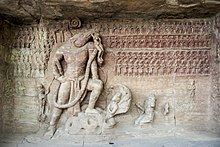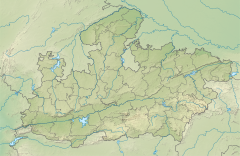| Udayagiri Caves | |
|---|---|
 | |
| Religion | |
| Affiliation | Hinduism, Jainism |
| District | Vidisha district |
| Deity | Varaha, Vishnu, Parshvanatha, others |
| Location | |
| Location | Udayagiri, Vidisha |
| State | Madhya Pradesh |
| Country | India |
| Geographic coordinates | 23°32′11.0″N 77°46′20″E / 23.536389°N 77.77222°E |
| Architecture | |
| Style | Gupta era |
| Completed | c. 250-410 CE[citation needed] |
The Udayagiri Caves are twenty rock-cut caves near Vidisha, Madhya Pradesh primarily denoted to the Hindu gods Vishnu and Shiva from the early years of the 3rd century CE to 5th century CE.[1][2] They contain some of the oldest surviving Hindu temples and iconography in India.[1][3][4] They are the only site that can be verifiably associated with a Gupta period monarch from its inscriptions.[5] One of India's most important archaeological sites, the Udayagiri hills and its caves are protected monuments managed by the Archaeological Survey of India.
Udayagiri caves contain iconography of Hinduism and Jainism.[6][5] They are notable for the ancient monumental relief sculpture of Vishnu in his incarnation as the man-boar Varaha, rescuing the earth symbolically represented by Bhudevi clinging to the boar's tusk as described in Hindu mythology.[3] The site has important inscriptions of the Gupta dynasty belonging to the reigns of Chandragupta II (c. 375-415) and Kumaragupta I (c. 415-55).[7] In addition to these, Udayagiri has a series of rock-shelters and petroglyphs, ruined buildings, inscriptions, water systems, fortifications and habitation mounds, all of which remain a subject of continuing archaeological studies. The Udayagiri Caves complex consists of twenty caves, of which one is dedicated to Jainism and all others to Hinduism.[4] The Jain cave is notable for one of the oldest known Jaina inscriptions from 425 CE, while the Hindu caves feature inscriptions from 401 CE.[8]
There are a number of places in India with the same name, the most notable being the mountain called Udayagiri at Rajgir in Bihar and the Udayagiri and Khandagiri Caves in Odisha.[6]
- ^ a b Upinder Singh (2008). A History of Ancient and Early Medieval India: From the Stone Age to the 12th Century. Pearson. p. 533. ISBN 978-81-317-1120-0.
- ^ Cite error: The named reference
dass25was invoked but never defined (see the help page). - ^ a b Fred Kleiner (2012), Gardner’s Art through the Ages: A Global History, Cengage, ISBN 978-0495915423, page 434
- ^ a b Margaret Prosser Allen (1992), Ornament in Indian Architecture, University of Delaware Press, ISBN 978-0874133998, pages 128-129
- ^ a b James C. Harle (1974). Gupta sculpture: Indian sculpture of the fourth to the sixth centuries A.D.. Clarendon Press, Oxford. pp. 7–9.
- ^ a b Cunningham 1880, pp. 46–53.
- ^ The inscriptions are dealt with in J. F. Fleet, Inscriptions of the Early Gupta Kings and their Successors, Corpus Inscriptionum Indicarum, vol. 3 (Calcutta, 1888), hereinafter CII 3 (1888); for another version and interpretation: D. R. Bhandarkar et al, Inscriptions of the Early Gupta Kings, Corpus Inscriptionum Indicarum, vol. 3 (revised) (New Delhi, 1981).
- ^ Cite error: The named reference
Schastok1985p36was invoked but never defined (see the help page).

